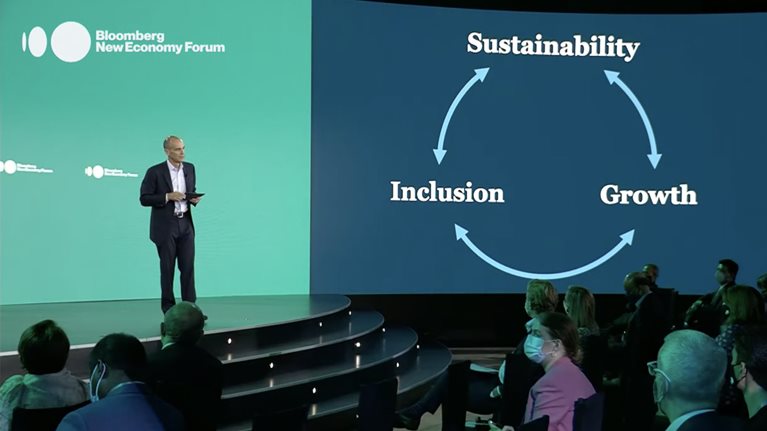In a ‘firestarter’ speech to help kick off Bloomberg’s recent New Economy Forum in Singapore, our global managing partner Bob Sternfels described high stakes around two “radically different paths” this decade could take. He urged leaders to act with courage in driving a “new age of prosperity” that would create a better quality of life for people and a more sustainable future for our planet.
You can read edited highlights from Bob’s speech below, or head over to Bloomberg to watch the session in its entirety.On the high-stakes of the next decade
I could paint two very different scenarios for how this decade could play out. The first: A new age of prosperity. GDP could grow 30 to 50 percent over this decade with a better quality of life for most people. A more sustainable future for our planet. True sustainable and inclusive growth. That’s one path. The second path doesn’t look so good. It has tepid economic recovery. Only 10 to 20 percent increase in GDP growth. Less equitable distribution. It’s less sustainable, with worse outcomes for global health and the environment.
So, two radically different paths—and the stakes couldn’t be higher. If we don’t substantially improve the net-zero commitments that we’ve all made, we’ll have one billion people living in lethal heat by 2050. Seven of 10 people today live in societies with growing inequality, and we’ve seen the massive stress that places on both public and private institutions. And in terms of economic growth, the bookend scenarios have never been wider than they are today as we forecast what could be.
On the opportunity to create sustainable and inclusive growth
At McKinsey we’ve done some modeling, and we believe that we could have three to four percent per annum GDP growth over this decade from existing technologies. Similarly, if we look at Europe in particular, those same technologies could abate 85 percent of the carbon [in that region] today. And if you look at job creation, there is a scenario with substantial net job growth over this decade. It requires investment in sectors from infrastructure to health care to energy. In fact, done right, job growth can outstrip jobs dislocated through technology two to one. But it requires the right focus on upskilling.
The goals of sustainability, inclusion, and growth can reinforce each other and create a virtuous circle. More inclusive health care could add half a point to global GDP growth by 2040. Advancing women’s economic potential in the workforce could add $13 trillion to global GDP growth. And growth rates for sustainable products and markets outstrip conventional ones 10 to 20 percent in all categories.

On the barriers to driving enduring change
Driving all three—sustainability, inclusion, and growth—won’t be easy and there’s some real tensions that need to be addressed. As technology is implemented at an ever faster rate, one hundred million people will need to be reskilled this decade. And energy transitions, if we don’t focus on inclusion, will be regressive. If I take the US alone, 60 percent of low-income households face severe energy burdens, meaning they spend over 10 percent of total household income on energy. Just transitions have to be a crucial component as we think about climate transition.
And I think we all know, as business leaders, that 40 percent of our workforce right now wants to change jobs in the next six months. The regulatory environment is increasingly uncertain, and we have multiple stakeholders to manage. If we want to be bolder, all these things have to come together.
On what it will take to lead forward
I’d argue it is a time for us as leaders to embrace long-term capital and to be courageous. We need to work together, and we need to move quickly. In reaching for a sustainable and inclusive growth, we have to work across the public/private divide. It’s the only way we’ll find solutions for things like standards for climate; for a mechanism that creates real incentives to invest in human capital; and for a framework that allows R&D investments to accelerate over this decade and solve some of these toughest problems.
We also have to move quickly. One thing that COVID has shown is that enterprise can move faster than any of us expected, which is good news because these problems aren’t going to be the problems of the next generation. They’re going to be the problems of our leadership generation. So the question I have is can we lock in this COVID speed to solve these particular issues.
The choice is ours. We have a moment right now to drive sustainable and inclusive growth. That won’t be easy, but I’d argue we should accept nothing less.

